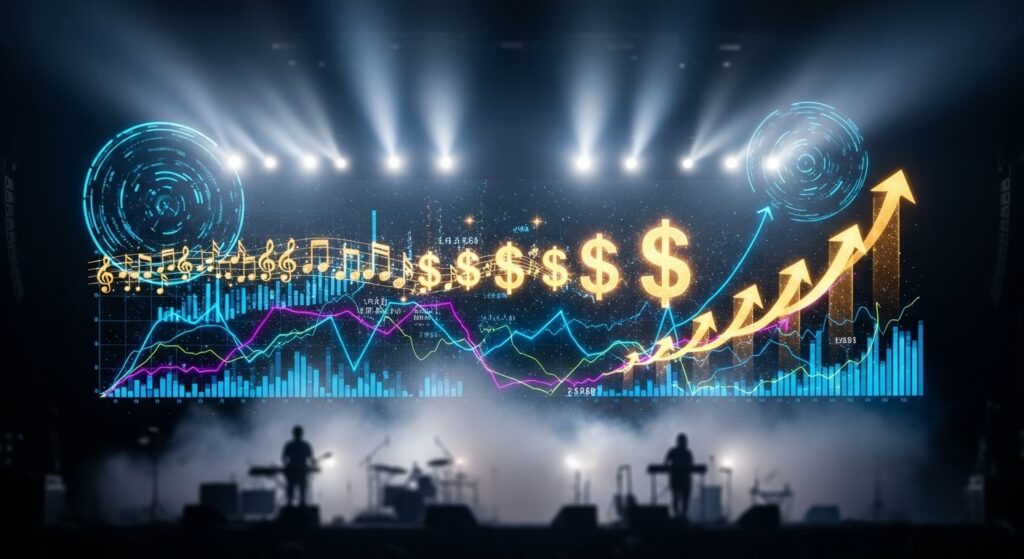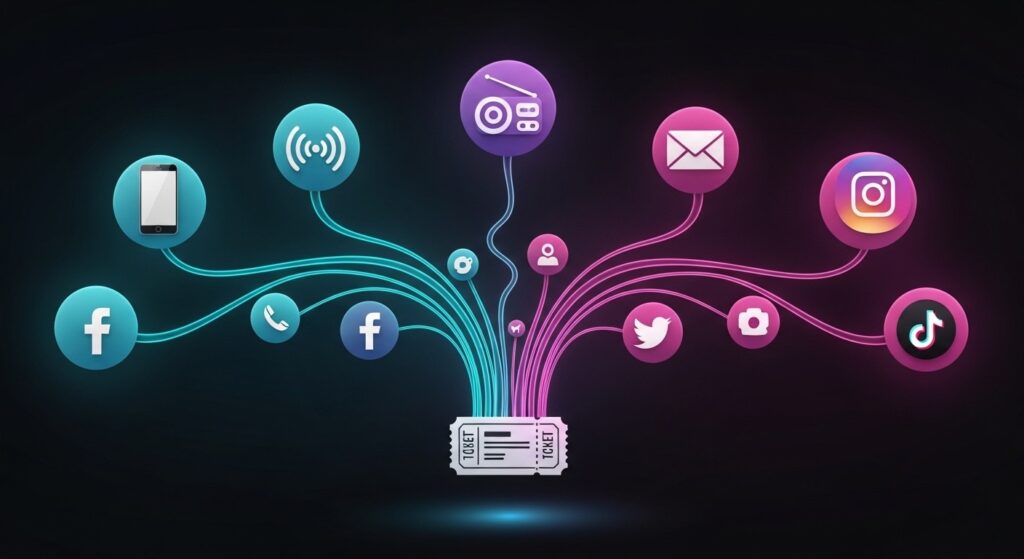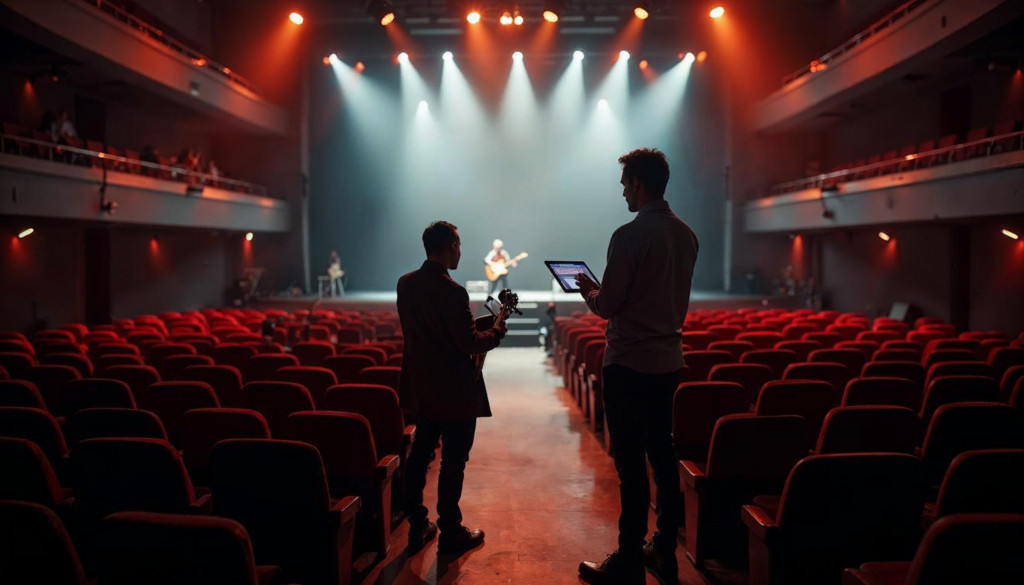
The Promoter’s Guide to Concert Marketing ROI
Concert marketing ROI isn’t just about ticket sales; it’s about measuring every touchpoint that drives revenue.
- Track campaign attribution across all channels to identify your highest converting marketing investments.
- Use real-time data to pivot strategies mid-campaign and optimize spend allocation.
- Implement promoter-specific KPIs like cost-per-ticket-sold and lifetime fan value to benchmark performance.
Stop throwing money at marketing campaigns you can’t measure, and start building a data-driven promotion machine.
Concert marketing ROI measures the total value generated from promotional investments relative to campaign costs, but many promoters are tracking the wrong metrics. While traditional event marketing focuses on basic attendance numbers and social media reach, concert marketing ROI requires a deeper understanding of how each marketing dollar directly influences ticket sales, fan acquisition, and long-term revenue generation.
The U.S. live music industry continues to demonstrate strong growth, with festivals generating billions in revenue annually. Yet many promoters struggle to connect their marketing investments to actual results.
What Is the Challenge of Tracking Concert Marketing ROI?
The challenge is understanding attribution. When a fan sees your Instagram ad, hears about the show on local radio, and finally purchases tickets through an email campaign, which channel gets credit? Smart promoters build attribution models that assign value across the entire customer journey, not just the final conversion point.
Concert ad metrics extend beyond impression counts and engagement rates. The most successful promoters track cost-per-ticket-sold (CPTS), lifetime fan value (LFV), and campaign contribution margins to make data-driven decisions that maximize both immediate sales and long-term audience development.
Why Do Traditional Metrics Miss the Mark?
Concert marketing campaigns generate ROI through multiple revenue streams. Understanding these channels helps promoters build comprehensive measurement frameworks that capture the full value of promotional investments.
Primary Revenue Drivers
Direct ticket sales are the most obvious ROI metric, but sophisticated promoters track velocity and attribution. Monitor not just total sales but how quickly tickets move at different price points and which marketing channels drive premium purchases versus general admission sales.
Merchandise and concession uplift often correlate directly with marketing campaign effectiveness. Well-promoted shows typically generate higher per-capita ancillary revenue compared to shows with minimal marketing support, as engaged audiences are more likely to make additional purchases.
Sponsorship revenue increases when promoters can demonstrate audience size and engagement to potential partners. Concerts with documented marketing reach and demographic data command higher sponsorship rates than those without comprehensive audience analytics.
Future booking opportunities result from successful shows that demonstrate a promoter’s ability to drive attendance and create profitable events. This long-term value multiplies the ROI of individual campaigns across an entire venue or promoter relationship portfolio.
Secondary Value Creation
Event marketing tools enable promoters to capture additional value through email list growth, social media following expansion, and audience data collection. These assets compound over time, reducing customer acquisition costs for future shows and creating direct marketing channels that bypass paid advertising.
Promoters must calculate fan lifetime value to understand true campaign ROI. A new fan acquired through a marketing investment might attend multiple shows over several years, generating hundreds of dollars in total revenue across various artists and venues.
What Concert-Specific Metrics Actually Matter for Promoter ROI Analysis?
Concert promoters need specialized metrics that reflect the unique dynamics of live music marketing. Unlike corporate events or product launches, concerts operate on compressed timelines with highly emotional purchase decisions driven by factors like artist popularity, venue reputation, and social proof.
Core Performance Indicators
Cost Per Ticket Sold (CPTS) provides the most direct measurement of marketing efficiency. Divide your total marketing spend by the number of tickets sold through trackable channels. This metric varies based on market size, artist popularity, and venue capacity, but provides vital benchmarking data for campaign optimization.
Marketing Contribution Margin measures how much profit each marketing dollar generates after accounting for all variable costs. Understand which campaigns truly drive profitable growth versus those that simply increase volume at unsustainable acquisition costs.
Channel Attribution Ratios reveal which marketing channels work together to drive conversions. For example, fans might discover an event through social media, research the artist on streaming platforms, and complete purchases through email campaigns. Understanding these interaction patterns helps optimize budget allocation.
Velocity Metrics track how quickly tickets sell following specific marketing activities. Monitor sales acceleration after email sends, social media posts, or radio advertisements to identify which tactics create immediate urgency versus those that build awareness over time.
Advanced Analytics
Audience Quality Scores measure the long-term value of fans acquired through different marketing channels. Fans from organic social media often attend multiple shows and refer friends, while those acquired through broad digital advertising may be one-time attendees with lower lifetime value.
Geographic Conversion Rates help you understand which locations respond best to different marketing approaches. Urban markets might convert efficiently through digital advertising, while suburban and rural audiences may require more traditional radio and word-of-mouth strategies.
Price Elasticity Measurements track how marketing messages influence willingness to pay premium prices versus general admission rates. This data helps optimize both marketing creative and pricing strategies to maximize total revenue per attendee.
Top 8 Data-Driven Strategies for Maximizing Concert Marketing ROI
1. Build Multi-Touch Attribution Models
Most concert marketing operates across multiple touchpoints, making single-source attribution inadequate for understanding true campaign performance. Use tracking systems that credit all marketing channels contributing to ticket sales, not just the final click.
Use UTM parameters on all digital marketing links, unique promo codes for radio and print advertising, and customer surveys to understand discovery paths. Advanced promoters employ marketing mix modeling to determine how each channel impacts overall sales performance.
2. Implement Real-Time Budget Optimization
Concert marketing windows are short and intense, requiring rapid response to campaign performance data. Set up automated budget shifting rules that move money from underperforming channels to those driving strong conversion rates.
Monitor campaign performance daily and establish clear performance thresholds that trigger budget reallocations. For example, if social media advertising achieves CPTS below target while radio spots exceed cost thresholds, redirect funds to scale successful digital campaigns.
3. Leverage Lookalike Audience Development
Build detailed profiles of your highest value customers (those who purchase tickets quickly, buy premium packages, and attend multiple shows). Use these profiles to create lookalike audiences on Facebook, Instagram, and Google advertising platforms.
Lookalike audiences can perform better than broad interest targeting, improving concert ad metrics and reducing customer acquisition costs through more precise audience matching.
4. Optimize Email Campaign Timing and Segmentation
Email marketing typically generates the highest concert promoter ROI, but timing and audience segmentation impact performance. Analyze your audience’s email engagement patterns to identify optimal send times and frequency caps.
Segment audiences based on past attendance behavior, genre preferences, and purchase timing. VIP customers might respond to early-bird campaigns, while price-sensitive fans need discount-focused messaging closer to show dates.
5. Create Content That Drives Organic Amplification
User-generated content from past shows often outperforms paid advertising for building social proof and driving ticket sales. Document every event extensively and create content systems that encourage fans to share their experiences.
Develop hashtag strategies, photo contests, and social media campaigns that turn attendees into brand ambassadors. Content that generates organic shares and saves reduces paid advertising dependency while improving overall campaign ROI.
6. Implement Dynamic Pricing Based on Marketing Performance
Adjust ticket prices based on marketing campaign performance and demand indicators. When campaigns drive strong initial sales velocity, gradually increase prices to maximize revenue from remaining inventory.
Monitor social media engagement, email open rates, and website traffic as leading indicators of demand. Use this data to optimize pricing strategies that capture maximum value while maintaining strong sales momentum.
7. Build Cross-Promotion Partnerships
Partner with complementary venues, artists, and local businesses to expand marketing reach without proportionally increasing costs. Cross-promotional campaigns often generate higher trust and conversion rates than solo advertising efforts.
Develop formal partnership programs that track referral sources and shared marketing costs. The most successful partnerships create ongoing relationships that reduce marketing expenses across multiple events while building stronger community connections.
8. Establish Post-Event Revenue Tracking
Concert marketing ROI extends through merchandise, food and beverage sales, and future event attendance. Use systems that track total per-attendee revenue and attribute it back to acquisition marketing channels.
This big-picture view of customer lifetime value gives teams the confidence to invest more in high-quality audience growth and make smarter, long-term promo moves that actually pay off.
Concert Marketing Attribution: Mapping the Customer Journey
To understand how fans discover, research, and purchase concert tickets, you must account for the emotional and social nature of live music. Unlike e-commerce purchases, concert tickets involve complex decision-making processes influenced by peer recommendations, artist loyalty, and timing factors.

First-Touch Attribution Models
Track the initial point of contact between potential attendees and event marketing. This might be a social media advertisement, radio announcement, or friend recommendation. First-touch attribution helps promoters understand which channels effectively create awareness and initial interest.
However, first-touch models often undervalue channels that drive final conversions. A fan might discover an event through Instagram but purchase tickets weeks later through email marketing. Comprehensive attribution gives appropriate credit to both awareness and conversion channels.
Multi-Touch Attribution Frameworks
Advanced promoters rely on attribution models that assign value across all touchpoints in the customer journey. Time-decay models give more credit to recent interactions, while position-based models emphasize both first-touch awareness and last-touch conversion.
Linear attribution models distribute credit equally across all interactions, providing balanced insights into campaign performance. The key is selecting models that reflect your specific audience behavior and marketing goals.
Social Proof and Referral Attribution
Concert marketing uniquely relies on social proof and word-of-mouth recommendations. Use tracking systems that capture referral sources through social media shares, direct links, and friend invitations.
Use social listening tools to monitor mentions and conversations about events across platforms. This qualitative data supplements quantitative models and helps promoters understand organic amplification generated by paid marketing investments.
Real-Time Campaign Optimization: Pivoting for Maximum Impact
Concert promotion timelines compress marketing decisions into weeks or days, making real-time optimization essential for maximizing promoter ROI. Unlike long-term brand marketing campaigns, concert promotion needs quick responses to performance data and market changes.

Daily Performance Monitoring
Establish daily reporting systems that track key metrics across all marketing channels. Monitor not just aggregate performance but hourly trends that reveal the best posting times, peak engagement periods, and conversion patterns.
Set up automated alerts when campaigns exceed or fall below thresholds. You can then act without waiting for weekly or monthly reporting cycles that might miss critical opportunities.
Mid-Campaign Strategy Pivots
Successful promoters maintain flexibility to shift marketing strategies based on real-time performance data. If social media advertising underperforms while email marketing exceeds expectations, rapidly reallocate budgets to boost that channel.
Build decision-making frameworks that let your team pivot fast without losing the thread. Set clear rules for when to shift budgets, refresh creative, or tweak channels so every move stays on-brand and drives better results.
Crisis Communication and Recovery
Concert marketing comes with unexpected challenges like lineup changes, venue modifications, or competitive events. Develop communication protocols that quickly address issues while maintaining ticket sales momentum.
Monitor social media sentiment and news coverage to identify potential problems before they hit sales. Proactive communication often prevents minor issues from becoming major marketing challenges that require expensive recovery campaigns.
In live music, the smartest promoters blend creativity with hard data. With advanced tracking, attribution, and optimization tools in play, they fine-tune every campaign, boosting performance and cutting customer acquisition costs along the way.
Frequently Asked Questions
What’s a good ROI for concert marketing campaigns? Successful concert marketing campaigns typically generate 3:1 to 5:1 ROI, meaning every marketing dollar produces $3–5 in ticket revenue. However, ROI varies based on venue size, artist popularity, and market conditions. Focus on improving your own baseline rather than comparing to industry averages.
How quickly should I see ROI from concert marketing? Concert marketing typically shows initial results within 24–48 hours of campaign launch, with peak performance occurring 1–2 weeks before show dates. Monitor daily metrics to identify successful strategies early and reallocate budgets to maximize performance throughout the promotional period.
Which marketing channels provide the best concert ROI? Email marketing consistently delivers the highest ROI for concert promotion. Social media advertising and partnerships with local businesses also perform well. However, the best channel mix depends on your specific audience demographics and market characteristics.
How do I track ROI across multiple marketing channels? Use UTM parameters for all digital marketing, unique promo codes for traditional advertising, and customer surveys to understand discovery paths. Implement multi-touch attribution models that credit all channels contributing to ticket sales, not just the final conversion point.
What metrics matter most for measuring concert marketing success? Focus on cost-per-ticket-sold (CPTS), marketing contribution margin, and customer lifetime value. These metrics provide direct insights into campaign profitability and long-term audience development, enabling data-driven optimization decisions that improve overall promotional performance.
Turn Concert Promotion Into Data-Driven Growth
Success in concert marketing requires balancing immediate ticket sales goals with long-term audience development objectives. The promoters who thrive understand that today’s marketing investments build tomorrow’s fan base, creating compound returns that surpass individual events.
Prism’s comprehensive venue management platform integrates marketing tracking, financial analysis, and campaign optimization tools specifically designed for live music professionals, helping promoters maximize ROI while minimizing administrative complexity. Get started today with a free demo.

Matt Ford is the founder and CEO of Prism.fm, an Austin-based software company revolutionizing live music event management. With a background in entrepreneurship and a degree from the University of Wisconsin-Madison School of Business, Ford combined his self-taught coding skills with firsthand experience as a concert promoter to address the inefficiencies he observed in the industry. In 2018, he launched Prism.fm, an all-in-one platform designed to streamline operations for venues, promoters, and agencies by replacing cumbersome spreadsheets with integrated tools for booking, financial tracking, and contract management. Under his leadership, Prism.fm has grown significantly, achieving $3 million in annual recurring revenue post-COVID and securing over $15 million in funding . Ford’s commitment to building user-centric solutions has positioned Prism.fm as a trusted partner for over 1,500 venues and promoters worldwide.



